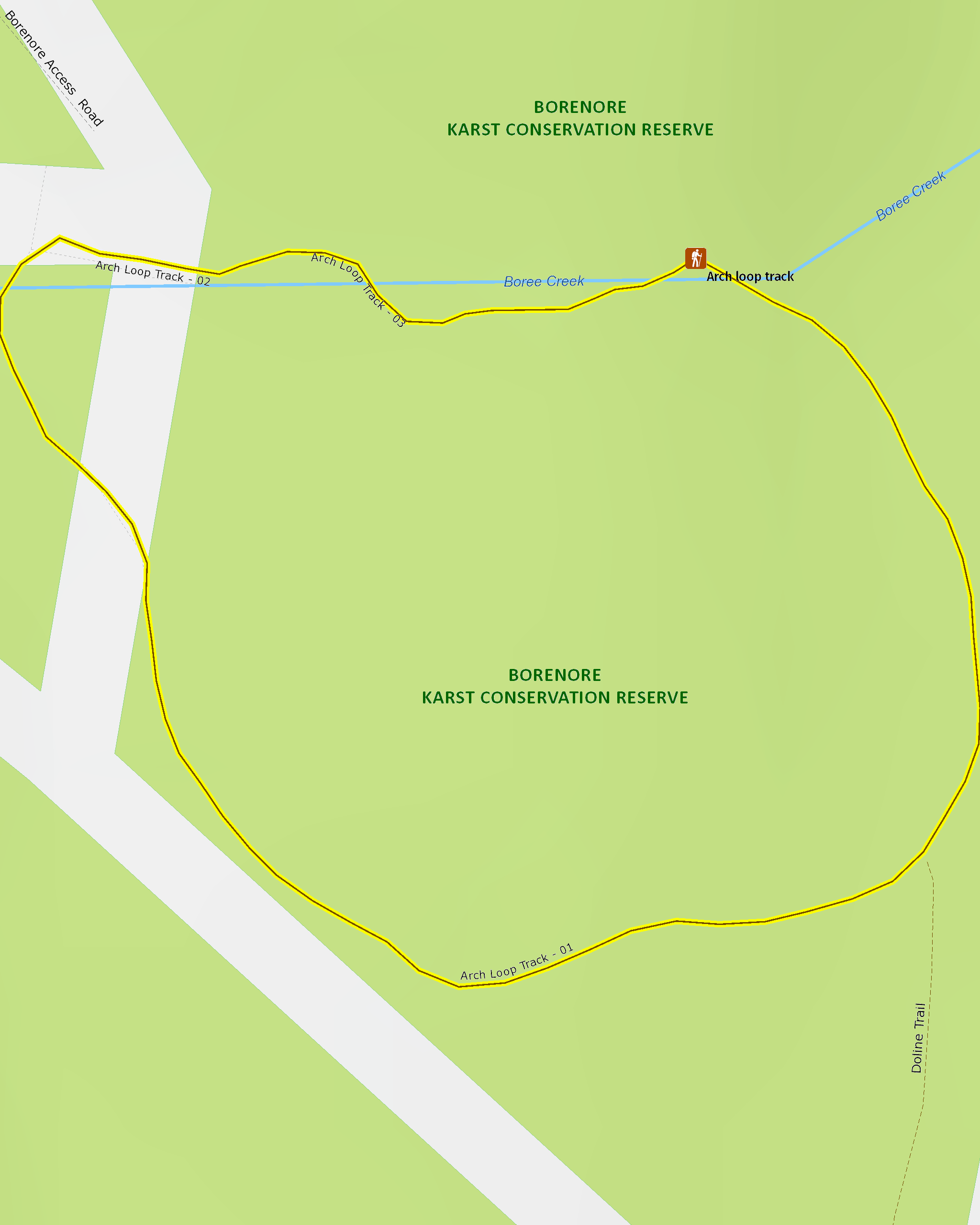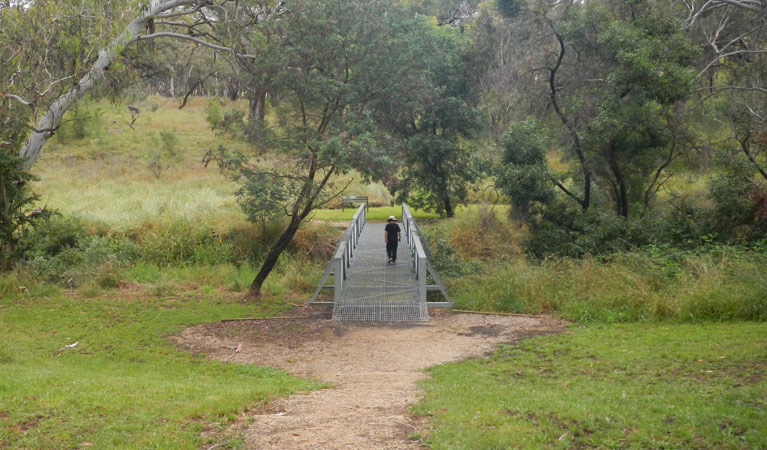Overview
Explore Arch Cave along the easy Arch loop track, a short walk from the picnic area. Look for stalactites, stalagmites and columns in the cool cavern.
- Accessibility
- Hard
- Distance
- 0.7km loop
- Time suggested
- 15 - 30min
- Grade
- Grade 3
- Opening times
- Arch loop track is open from 9am to 7pm every day, but may have to close at times due to poor weather or fire danger.
- Please note
- Watch out for low roof levels or you may bump your head
- Water levels in caves may rise very quickly during rain and thunderstorms. Always check the expected weather conditions before entering any of the caves. If rain is predicted, consider putting off your cave trip till another day.
- The ground in the cave can be slippery, so take care, wear sturdy shoes and take a torch
- The oil on our skin alters the way stalactites and stalagmites grow and can even change the colour of the rock, so please look but don’t touch
- Please do not damage or remove rocks from the area
- Find out how to make your own stalactite or stalagmite at home
The best way to explore the mysterious Arch Cave is on the Arch loop track. This easy walk starts and finishes at the Borenore picnic area, simply cross the footbridge from the picnic area and it’s just a short walk to the cave.
Take your time along the walk to check out the rock formations, they are quite striking close up and feature black, orange and yellow striped markings. Once you’re inside the caves, go slow to let your eyes adjust, or flick on your torch.
Look to the roof of the cave for the stalactites that cling tightly and to the stalagmites that grow upwards from the ground. Do you know what happens when the stalactites and stalagmites meet? They become a column; see how many you can count.
Spend as long as you like in the cave, from here, it’s just an easy walk back through woodland to the picnic area.
Map

Map legend

Local alerts
For the latest updates on fires, closures and other alerts in this area, see https://www.nationalparks.nsw.gov.au/things-to-do/walking-tracks/arch-loop-track/local-alerts
General enquiries
- National Parks Contact Centre
- 7am to 7pm daily
- 1300 072 757 (13000 PARKS) for the cost of a local call within Australia excluding mobiles
- parks.info@environment.nsw.gov.au
Park info
- in Borenore Karst Conservation Reserve in the Country NSW region
Borenore Karst Conservation Reserve is open 9am to 7pm every day but may have to close at times due to poor weather or fire danger.
Visitor info
All the practical information you need to know about Arch loop track.
Track grading
Features of this track
Distance
0.7km loop
Time
15 - 30min
Quality of markings
Clearly sign posted
Experience required
No experience required
Gradient
Short steep hills
Steps
Many steps
Quality of path
Formed track, some obstacles
Getting there and parking
Get driving directions
Arch Loop track starts at Borenore picnic area, approximately 1km from the entrance
Parking
Parking is available at the Borenore picnic area.
Best times to visit
There are lots of great things waiting for you in Borenore Karst Conservation Reserve. Here are some of the highlights.
Autumn
Let your inner geologist loose among the limestone and see if you can spot the remnants of marble quarries and mines from the past.
Spring
Check out the wildflowers and birds in the endangered box gum woodland.
Summer
Escape the heat and step into magical Arch Cave while walking the Arch Cave loop track.
Weather, temperature and rainfall
Summer temperature
Average
15°C and 25°C
Highest recorded
38.3°C
Winter temperature
Average
2°C and 12°C
Lowest recorded
-5.6°C
Rainfall
Wettest month
August
Driest month
April
The area’s highest recorded rainfall in one day
98.6mm
Maps and downloads
Accessibility
Disability access level - hard
Wheelchairs can access this area with some difficulty
- Wheelchair access is possible across Boree creek and along a partially gravelled path to the base of the steps leading to the Arch Cave
- Wheelchair access to Arch Cave is not possible
- Wheelchair access to the woodland area may be possible with strong assistance as the walking track is across natural ground surface, note there are protruding rocks and a steep slope
Prohibited
Pets
Pets and domestic animals (other than certified assistance animals) are not permitted. Find out which regional parks allow dog walking and see the pets in parks policy for more information.
Smoking
NSW national parks are no smoking areas.
Learn more
Arch loop track is in Borenore Karst Conservation Reserve. Here are just some of the reasons why this park is special:
Aboriginal connections

The permanent flow of Boree creek and the reliable shelter of caves meant that this area was used for thousands of years by the Wiradyuri people. In fact, the name 'Borenore' is believed to be derived from two Wiradyuri words: bora which means ceremony and nora nora meaning shelf or overhanging rock. The reserve remains an important place for Aboriginal people today and protects a number of ancient sites, including Arch Cave which is highly significant for local Aboriginal women as a maternity site.
From limestone to marble

Marvel at the stalactites and stalagmites at Borenore Karst Conservation Reserve. The karst or limestone, as it is better known in the reserve, probably began life as limey mud and coral reefs some 390-400 million years ago when the area was located off the east coast of Australia. Around 12 million years ago, nearby Mount Canobolas spewed lava over the limestone, turning it into marble. Borenore marble, known as Borenore Red, was used in many public buildings in Sydney, including Transport House in Macquarie Street, and countless marble fireplaces.
- Arch loop track Explore Arch Cave along the easy Arch loop track, a short walk from the picnic area. Look for stalactites, stalagmites and columns in the cool cavern.
- Verandah Cave Take the easy walk from Borenore picnic area to Verandah Cave, where you can explore its limestone outcrops and pools of water in Borenore Karst Reserve.
Mystical adventure

Home to the ancient Arch Cave, Borenore Karst Conservation Reserve harbours a whole world that thrives in the dark. Light up your head torch and marvel at the stalactites and stalagmites. Listen to the drips of water around you that keep the air moist, the perfect breeding ground for the mosses and lichen surrounding the entrance. The musky smell you will notice is the tell-tale sign that bats are about as the caves are a precious home to these protected species.
- Borenore picnic area With a large grassy area, barbecues and picnic tables, Borenore picnic area is a great place for a family picnic. After lunch, take an easy walk to explore Arch Cave.
Protecting the precious

Borenore Karst Conservation Reserve plays a special role in the preservation of some of Australia's precious native flora and fauna. A haven for birds, the park is home to thornbills, honeyeaters, kookaburras, magpies, treecreepers, weebills and more. Another special flying creature finding protection here is the eastern bent-winged bat, a threatened species that spends the winter hibernating in Tunnel Cave, before emerging in spring ready to migrate. Borenore Karst Conservation Reserve also contains the endangered box gum woodland vegetation community.
- Verandah Cave Take the easy walk from Borenore picnic area to Verandah Cave, where you can explore its limestone outcrops and pools of water in Borenore Karst Reserve.

